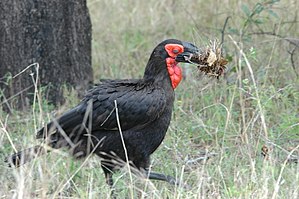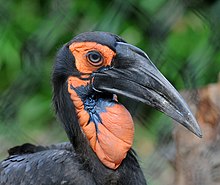Southern ground hornbill
| Southern ground hornbill | ||||||||||
|---|---|---|---|---|---|---|---|---|---|---|

Southern ground hornbill ( Bucorvus leadbeateri ) collecting nesting material |
||||||||||
| Systematics | ||||||||||
|
||||||||||
| Scientific name | ||||||||||
| Bucorvus leadbeateri | ||||||||||
| ( Vigors , 1825) |
The Southern Ground Hornbill ( Bucorvus leadbeateri , Syn. : Bucorvus cafer ), sometimes called Rotwangenhornrabe , Südhornrabe or Kaffer hornbill called, is a bird art from the family of hornbills (Bucorvidae) and a characteristic bird of African savannahs south of the equator . The southern ground hornbill and its sister species , the northern ground hornbill ( Bucorvus abyssinicus ) or Sudan hornbill, are the only representatives of the ground hornbill family. This bird can be clearly identified with its large beak, black plumage and the reddish color of the featherless face and neck areas.
Appearance
Body measurements and weights
The southern ground hornbill has a body length of 90 to 100 centimeters and a wingspan of almost two meters. The weight of the birds is very variable. Adult males weigh between 3.5 and 6.2 kilograms with an average weight of 4.1 kilograms. Females are slightly lighter and weigh between 2.2 and 4.6 kilograms with an average weight of 3.3 kilograms.
The high variability in body weight is also reflected in the body measurements. Males have a wing length between 47 and almost 62 centimeters. The average is around 56 centimeters. The tail is 30 to 36 centimeters long and the beak is between 19 and 22 centimeters long.
In females, the wing length of 10 measured birds was between 49 and 55 centimeters. The tail was 30 to 36 centimeters in length and the beak was 17 to 21.5 centimeters in length.
plumage
The southern ground hornbill has predominantly black plumage. Only shortly before moulting does the plumage appear sooty-brown. Only the feathers of the feathers are white, but this can usually only be seen in birds flying or cleaning themselves. The featherless parts of the face are bright red. The throat and the upper, front part of the neck are of the same red color. The beak is black or gray-black. He only has a hinted horn in the form of a beak at the base. This attachment is somewhat more pronounced in the male.
The birds have long eyelashes on the upper eyelid, the eyes are gray-green to yellow. Legs and feet are black. Females tend to be slightly smaller than males and have a central blue throat spot. The plumage of the smaller and lighter young birds appears sooty-black. On the wings of the hand, which are pure white in adult birds, young birds have black spots. The beak is smaller and its color is more like a dark gray. Young birds can be identified most clearly by the color of the feathered face and neck areas. With them the color is still a pale gray-brown there.
Possible confusion with other bird species
The southern ground hornbill can actually only be confused with the northern ground hornbill (Sudan hornbill), which is found in the south-east of Uganda and in the north-west of Kenya.
The northern ground hornbill is very similar to the southern ground hornbill. However, the two species differ noticeably in terms of their facial coloring. The featherless parts of the face and neck are of a rather bluish color in the northern ground hornbill.
voice
The calls of the southern ground hornbill can be heard especially at dawn and dusk. These are deep, far-reaching "Hoo Hoo Hoo-hoo" calls that are called in monotonous sequence at a pitch of 200 Hz and can be heard up to five kilometers away on calm days. Both the males and the females call.
If they are looking for food in pairs in the steppe , they call strictly alternately. Presumably the animals estimate the distance to their partner with the help of the call speed caused by the running time of the sound if they cannot see them in the tall grass of the steppe.
distribution and habitat
The southern ground hornbill lives in Africa south of the equator . It is found preferentially in open savannah landscapes .
Way of life
activity
Southern ground hornbills are true to their location. They live in groups of 2 to 12 birds, and they claim a territory of up to 100 km², which they actively defend against other groups. A group consists of a dominant , breeding pair and a number of other adult male birds and young birds of different sex. Adult females sometimes live singly, often seeking proximity to larger mammals or joining neighboring groups. The birds are constantly in search of food, walking slowly across the earth and examining the ground with their beak . More difficult prey such as snakes or small mammals are killed by several animals together.
nutrition
The southern ground hornbill searches for its food almost exclusively on the ground. It prefers to feed on large insects , small rodents and small snakes and, in small quantities, on fruits . He seldom feeds on carrion .
Reproduction and development
Southern ground hornbills build their nests in natural tree hollows. They are set up by the brooding couple and helpers and fed with dry grass and leaves . Unlike most other hornbills, they do not close their nests. The breeding season is from October to December. The female is cared for by the group members during breeding. The eggs are white with a grainy surface. From the two eggs that the female lays, the first chick hatches after about 40 days, with a birth weight of 60 grams. This already weighs 250 grams when the second hatches after about four days. The second chick often starves to death because it is inferior to the firstborn in the struggle for food. The group feeds the chicks up to ten times a day. After about 85 days the chicks are fully fledged, but the parents and the group will take care of them for a few more months. Southern ground hornbills live up to forty years old, while animals in captivity can live up to 60 years.
Systematics
The southern ground hornbill is one of the ground hornbills. The only other representative of the family is the Sudanese horn raven ( Bucorvus abyssinicus ).
Inventory development
The population is declining, especially due to the destruction of the birds' natural habitat . In South Africa , the second eggs are collected in nature conservation projects and the chicks, which otherwise would usually starve to death, are raised by people in order to then release them into the wild. The southern ground hornbills are currently classified as endangered ( Vulnerable in the IUCN Red List ).
Humans and southern ground hornbills
Folk beliefs, medicine and culture
Ground hornbills are considered sacred birds in many areas of southern Africa. Since they eat snakes and grasshoppers , among other things , they are considered useful animals and are rarely hunted.
Use in literature
The southern ground hornbill appears very rarely in the literature. It was used as the cover of the book Using Samba published by O'Reilly Verlag .
literature
- Alan Kemp: The Hornbills - Bucerotiformes , Bird Families of the World, Oxford University press 1995, ISBN 0-19-857729-X
Web links
- Videos, photos and sound recordings of Bucorvus leadbeateri in the Internet Bird Collection
Individual evidence
- ↑ a b c Kemp: The Hornbills - Bucerotiformes . 1995, p. 95
- ↑ Bucorvus leadbeateri in the IUCN Red List of Threatened Species . Retrieved November 19, 2011.

